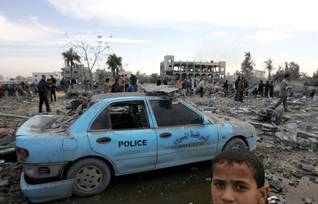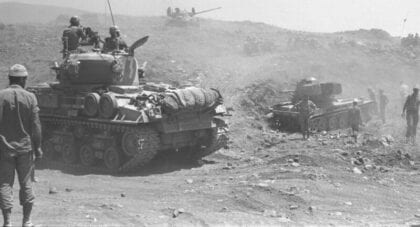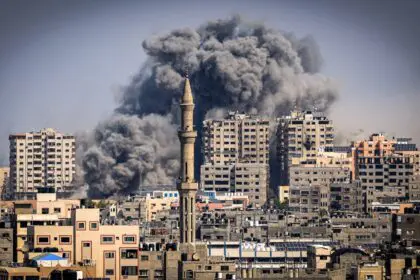The First Gaza War, Operation Cast Lead, which unfolded between December 27, 2008, and January 18, 2009, stands as a pivotal and contentious chapter in the Israeli-Palestinian conflict.
Background: The Fragile Ceasefire (2008)

Six months prior to the conflict, Israel had brokered a ceasefire with Palestinian armed groups in Gaza, effective from June 19, 2008.
This truce aimed to reduce hostilities along the border and alleviate suffering within the Gaza Strip. Nevertheless, the ceasefire was marred by sporadic breaches and escalating tensions.
At a time when international media speculated widely about a pending Israeli strike against Iranian nuclear facilities, the Israeli Armed Forces were busy preparing another operation, in order to destroy as much of Hamas as possible.
Critics say that an additional goal was to show that the Israeli Armed Forces had learned sobering lessons from the bloody confrontation with Hezbollah in 2006.
As of the summer of 2008, a ceasefire had been in place. Hamas would cease its rocket attacks and in return Israel would lift the blockade of Gaza. As is so often the case in the region, this ceasefire was delicate. Hamas stopped firing homemade Qassam rockets from the Gaza Strip into Israel and Israel partly lifted the blockade, nevertheless keeping a firm grip on the movement of goods and persons to and from the Strip.
A significant point of contention was the reopening of Gaza’s border crossings. While Hamas contended that the ceasefire included an agreement to lift the Gaza blockade, Israeli authorities disputed this claim. Although Israel partially resumed operations at one border crossing, the overall blockade policy remained largely unchanged. Approximately two months into the ceasefire, the United Nations reported a decrease in the flow of goods into Gaza.
For several months, an uneasy calm prevailed until November 4, 2008, when Israeli forces launched a raid into the Strip, leading to the death of six Hamas members. This air attack incident, coinciding with the U.S. presidential elections, marked a critical turning point, signaling the ceasefire’s end and the onset of Operation Cast Lead.
Following November’s 4th bloody Israeli air attack, Hamas was not prepared to renew the ceasefire after it expired on the 19th of December 2008.
The Israeli Assault: Operation Cast Lead Unleashed (December 2008)
Operation Cast Lead, also known in the region as the Gaza Massacre (Arabic: مجزرة غزة), occurred in two distinct phases. It began with a relentless week of aerial bombardment and was succeeded by two weeks of a joint air and ground assault.
The offensive commenced at 11:30 a.m. on December 27, 2008, involving Israeli F-16 fighter jets, Apache helicopters, and unmanned drones targeting over 100 locations across the densely populated Gaza Strip.
As Israeli Air Force jets attacked Hamas infrastructure in northern and central Gaza. The offensive caught Hamas off guard.

Among the other initial targets were four Palestinian police stations, including Gaza City’s central police headquarters, where a police officer graduation ceremony was underway. Tragically, the opening minutes of the attack resulted in the loss of 99 police personnel and nine civilians, with the death toll rising to at least 230 Palestinians by the end of the first day.
On the second day, the target list of the widening air offensive included, apart from the Hamas infrastructure, port facilities and police stations. Observers around the globe already wondered whether the military actions were a replay of the operations against Hezbollah in 2006.
After the first eight days, the Israeli cabinet approved a ground incursion into the Strip. The intense shelling and artillery fire on Hamas strongholds in Gaza persisted until January 3, 2009, when Israeli ground forces entered Gaza from the north and east. Simultaneously, Israel’s navy shelled Gaza from offshore positions.
Israeli infantry, backed by Israeli Air Force fighter jets, helicopter gunships and UAVs, entered the north of the Strip, with the declared mission of destroying Hamas infrastructure. The Israeli government approved an additional draft of thousands of reserve soldiers above the more than 6,000 that had already been mobilised shortly after the start of the operation.
According to a defence analyst in the American magazine Aviation Week, the tactics employed differed from those used against Hezbollah in 2006. ‘Following a week of precision bombing’, the ground campaign opened with three infantry brigade task forces simultaneously entering the Gaza Strip from several directions.
The infantry brigades approached their objectives from unexpected directions, avoiding previously used routes in which Hamas created booby trapped bunkers and tunnels.’ Basically, the Israeli Armed Forces sliced the Gaza Strip into small areas held by Hamas fighters. By slicing up the Strip the Israeli forces cut supply lines to Hamas from the tunnels in the south. As a result, these areas could be subdued more easily.
After 22 days of an unequal battle Israeli forces withdrew from the Gaza Strip (18 January 2009) and humanitarian convoys re-entered. In total around 1,400 Gazans were killed (80 percent of whom were civilians), against thirteen Israeli (mostly military personnel, several due to ‘friendly fire’).
The conflict concluded on January 18, 2009, amid significant international pressure, just two days before President Barack Obama’s inauguration. Israel declared a unilateral ceasefire and withdrew its forces from Gaza, a move reciprocated by Palestinian armed groups with a separate unilateral ceasefire.
Objectives and Allegations of War Crimes (2008-2009)
Operation Cast Lead had conflicting objectives. Israel asserted its aim was to halt indiscriminate rocket fire from Palestinian territories into Israel and to curb weapons smuggling into Gaza. In contrast, Hamas maintained that its rocket fire, which resumed in November 2008, was a response to an Israeli raid into a tunnel leading from Gaza—a move it perceived as a ceasefire violation. Israel insisted the raid was a preemptive strike against a tunnel believed to be intended for abducting Israeli border guards.
During the initial air assault, Israeli forces targeted police stations, military installations, weapons caches, suspected rocket-firing teams, and political and administrative institutions, leading to significant destruction in densely populated areas like Gaza, Khan Yunis, and Rafah. In retaliation for these attacks, Palestinian groups fired rockets, further escalating the hostilities.
The international community expressed deep concerns about indiscriminate attacks on civilians and civilian structures during the conflict, which raised significant questions about international law violations.
International Inquiry into Operation Cast Lead (2009)
In April 2009, in response to mounting global outrage over the devastating impact of Operation Cast Lead, the United Nations Human Rights Council established a Fact-Finding Mission. This mission was tasked with investigating potential violations of international law during the conflict, reflecting widespread concerns regarding the conduct of the hostilities.
Leading the inquiry was Justice Richard Goldstone, a highly respected former judge of the Constitutional Court of South Africa and a seasoned war crimes prosecutor who had previously served in Rwanda and the former Yugoslavia.
The mission initiated an extensive fact-finding endeavor, with its four members conducting comprehensive fieldwork in Gaza during late May and early June 2009. They conducted in-depth hearings in the region and Geneva, interviewing a remarkable 188 individuals. To thoroughly understand the events of Operation Cast Lead, they scrutinized more than 10,000 pages of documents, analyzed over 30 videos, and studied 1,200 photographs.
Despite calls from the international community for cooperation and transparency, Israel chose not to engage with the Fact-Finding Mission. This decision, unfortunately, prevented the mission from meeting Israeli officials or accessing the West Bank, which could have provided crucial insights and context.
As the culmination of their meticulous investigation, the mission produced a comprehensive report known as the “Goldstone Report.” Spanning 575 pages, this substantial document meticulously outlined the alleged war crimes and crimes against humanity committed during Operation Cast Lead, with a specific focus on the actions of the Israeli military.
The Goldstone Report maintained a balanced perspective. It acknowledged that Palestinian armed groups had also committed war crimes, primarily through indiscriminate rocket attacks targeting Israeli civilians in proximity to Gaza. This balanced approach underscored the mission’s dedication to impartiality and truth-seeking.
Goldstone Report: Revelations & Allegations of Violations (September 2009)
The Goldstone Report (September 2009) illuminated 36 specific cases and incidents in which Israeli forces were accused of violating international laws during the Gaza offensive. Some of these incidents remain etched in memory due to their gravity:
Samouni Family Massacre:
One of the most infamous events during the war involved Israeli soldiers herding approximately 100 members of the Samouni family into a single building in Gaza City’s Zaytoun area. Tragically, the family was detained in the building for 24 agonizing hours before a shelling struck the structure on January 4, 2009, resulting in the death of 21 family members, all of whom were civilians.
Al-Daya Family Massacre:
On January 6, another grievous event occurred when an Israeli F-16 jet launched a missile at the home of the Al-Daya family in Gaza City’s Zaytoun neighborhood. This tragic strike led to the loss of 22 family members, the majority of whom were women and children.
White Flag Killings:
The Goldstone Report and various human rights organizations highlighted several instances in which witnesses recounted Israeli soldiers taking the lives of Palestinians who were fleeing with makeshift white flags—a universal symbol of civilian status. One such case involved the tragic deaths of two women, Majda and Rayya Hajjaj, aged 37 and 65, respectively. These women were fleeing with their families while brandishing a white flag in the town of Johr Ad-Dik. A soldier responsible for this incident faced legal repercussions, receiving a 45-day prison sentence in August 2012. This marked the only case with significant charges related to Cast Lead.
Use of White Phosphorus in Populated Areas:
The Goldstone Report, along with corroborating accounts from rights groups and journalists, underscored multiple instances of the use of white phosphorus—a highly incendiary substance that is illegal for use in populated areas. Israeli forces deployed white phosphorus in attacks on at least two hospitals, Al-Quds
Hospital and Al-Wafa Hospital, as well as the central UN compound in Gaza City. Tragically, these deployments resulted in numerous civilian casualties within the densely populated confines of the Strip.
Israeli strikes on the Palestinian Legislative Council building & Gaza main prison:
The Richard Goldstone Mission investigated (among others) the Israeli strikes on the Palestinian Legislative Council building and the Gaza main prison, both of which were completely destroyed and rendered unusable.
Israeli government and armed forces representatives argued that these buildings were part of the “Hamas terrorist infrastructure,” justifying the attacks. However, the Mission rejects this argument. It found no evidence that these buildings made an effective contribution to military actions.
The Mission concluded that these attacks were deliberate acts against civilian structures, in violation of customary international humanitarian law, which mandates that attacks must strictly target military objectives. These actions also indicated the commission of a grave breach of extensive property destruction, not justified by military necessity, and conducted unlawfully and recklessly.
A Broader Perspective on Allegations
In addition to the Goldstone Report, human rights organizations such as Amnesty International and Human Rights Watch independently published reports documenting a litany of allegations of war crimes committed by Israeli forces during Operation Cast Lead. These reports emphasized the magnitude of the issues at hand, highlighting the urgency for a comprehensive and impartial investigation into the conflict and the importance of holding those responsible for alleged violations of international law accountable.
Operation Cast Lead, while officially over, continued to resonate within the domains of international law, humanitarian considerations, and human rights discourse. The Goldstone Report, in particular, served as a beacon of transparency and truth, scrutinizing actions taken by both sides of the conflict.
History of the Palestinian-Israeli Conflict
This article is part of our coverage of the history of the Palestinian-Israeli Conflict.
Fanack’s historical record meticulously chronicles the Palestinian-Israeli Conflict in a chronological sequence, encompassing its origins, crises, wars, peace negotiations, and beyond. It is our most exhaustive historical archive.



